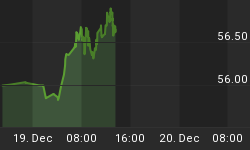The world is drowning in Fiat currency and the only thing that can preserve your wealth is if the world's central bankers return to a gold standard. Until they do, you better own some gold.
Only weeks ago, the now-retired Alan Greenspan repeated his oft-stated contention that during his tenure as Chairman of the Federal Reserve, the central bank managed monetary policy as if the U.S. were still on the gold standard. I doubt Mr. Greenspan is really that uninformed about the machinations of the Fed, so one must conclude that he is obfuscating the truth. For his statement to be correct, he must believe that the inflation rate of the money supply is commensurate with the inflation rate of gold. In fact, the inflation rate of gold has averaged nearly 2% per annum during his reign.
Problem is, the average increase in the M3 aggregate was 5.85% during his tenure. More amazingly, according the St. Louis Fed that same aggregate increased by 8.9% from November 2004 to November 2005, dates I point out to illustrate Mr. Greenspan's obstinacy until the bitter end.
In fact, in the last 35 years, M3 money supply increased 7.8% per year on average. The Fed's playbook response to the inflation it creates is to raise short term rates in order to slow economic growth, but such growth has nothing to do with inflation. The problem today is that while the Fed is increasing the cost of money, at the same time it is greatly boosting its supply. It is noteworthy to point out that even during times of dramatic rate increases, money supply growth remained intractable. From 1978 to 1981, the effective Federal Funds Rate went from 5% to 19%; however, during that same timeframe the rate of expansion of the monetary base continued unabated.
The U.S. is not alone in destroying the purchasing power of its currency. Since the inception of the Euro, the E.C.B. has expanded the money supply by an average of 9% per annum and Asian nations are constantly busy diluting their monetary bases as they try to keep their currencies from rising against the dollar. The result? All this money needs to find a home; fortunately for the U.S., for now a good deal of that cash ends up in our bond market. So, in a perverse anomaly of economic principles, inflation is keeping the yield on treasuries artificially low. This situation cannot last indefinitely, however.
Like the U.S. equity market in 2000 and the housing market today, the bond market will one day have to succumb to reality. Alan Greenspan's "conundrum" is now Bernanke's problem and it will likely be solved as long rates soar and the yield curve steepens, which will occur when tortured C.P.I. numbers come to be viewed by more investors as useless economic data. Recent evidence of Fed machinations can be seen in the central bank's decision to pull the plug on M-3 data, declaring it no longer useful. In reality, M3 rate increases are much closer to what true inflation rate is because the intrinsic rate of inflation is equal to the rate of increase in the money supply, precisely what M-3 measures.
The change in the cost of a good is generally equal to the difference between the inflation rate of that good vis-a-vis the inflation rate of the money supply. This assumes the intrinsic value of the good remains constant, e.g. if gold was found to have anti-cancer properties then its intrinsic value would increase outside the influence of the money supply. An important thing to note about inflation is that it is not the same for everyone and everything. Inflation rates vary between asset classes. The person who has owned a home for the past several years has experienced a different impact from inflation than the individual who has been a renter -- just ask a former renter who has recently purchased a home at today's inflated values if he agrees with the governments statistics on C.P.I. Or, better yet, mark it down to ask an investor purchasing a 10-year treasury a decade from now if it was a good idea to believe the government's assertion that inflation was quiescent.
Foreign central banks now hold more than 40% of U.S. treasuries but their willingness to continue recycling our trade deficit and holding dollar-denominated assets may be starting to wane. Indeed, some are looking to diversify and starting to accumulate gold ( Argentina and Russia stand as examples). At the same time, it is no secret that the American consumer cannot be expected to pick up the slack as our domestic savings rate is negative. And all the while, the U.S. is heading deeper into a demographic time bomb, one which will become more acutely salient in the next decade as slower growth, higher inflation, onerous tax rates and prohibitive interest rates will be the likely result.
Eventually governments will learn their lessons, but probably not until the champagne goes flat and the hangover sets in. Only then can we hope to return to the sanity of a gold standard. Only when have sobered up will we ask why we ever trusted a group of central bankers with our money supply.
*Investors are increasingly turning to Canada for non-U.S. Dollar exposure. Get "Go North!" our exclusive, free report on Canadian royalty trusts by clicking here. And to buy physical gold bullion for only .4%, contact us to gain our exclusive discount code on BullionVault.com.















